Abstract
Polymorphonuclear leukocytes (PMN) isolated from human blood were exposed to various levels of hydrogen sulfide. The effect on respiratory burst, myeloperoxidase activity, and capacity to phagocytose and kill bacteria were studied. A 1-h exposure of the PMN to 1 mM sulfide did not decrease their myeloperoxidase activity or their capacity to initiate a respiratory burst. Actually the products of the respiratory burst rapidly oxidized sulfide. The phagocytosis and killing of bacteria in the presence of 1 mM sulfide was only decreased to a minor extent. Myeloperoxidase in cell extract was, however, almost completely inhibited by 1 microM sulfide. These results indicate that hydrogen sulfide does not easily permeate PMN. PMN may be able to function in infected sites with high sulfide levels such as in the gingival pockets of periodontal disease. In the oxygenated areas of these sites the PMN may actually help in the detoxification of sulfide.
Full text
PDF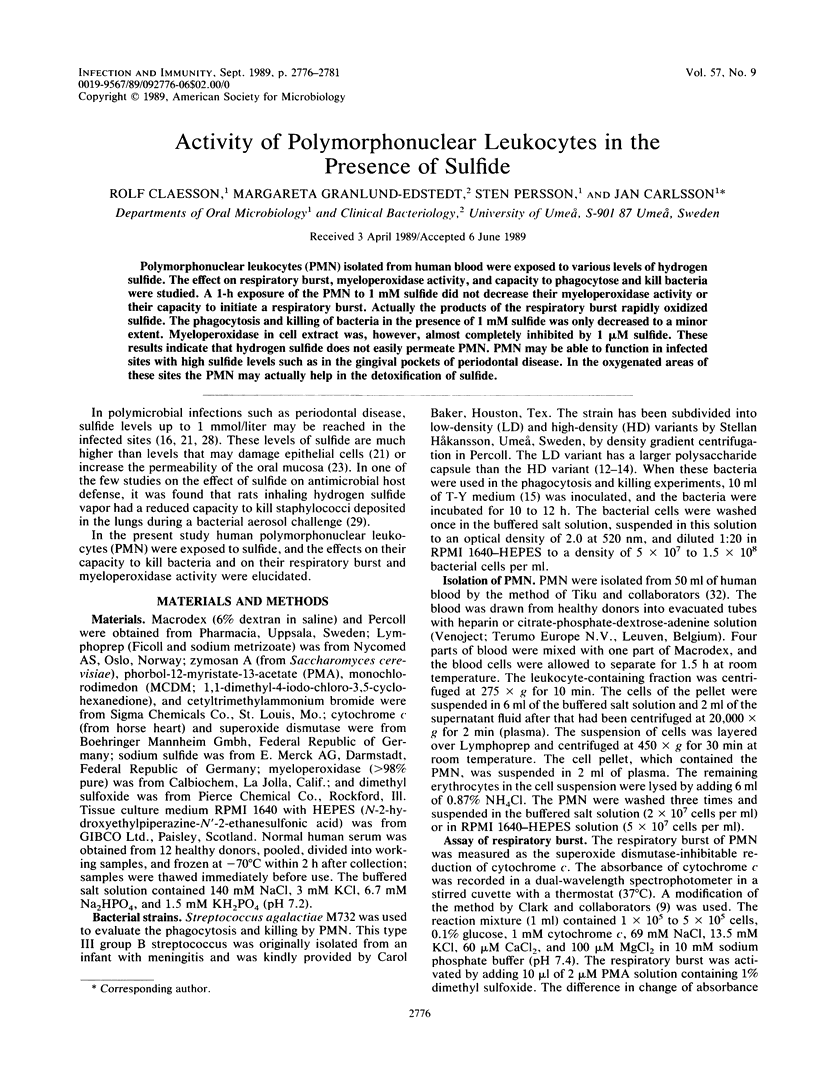
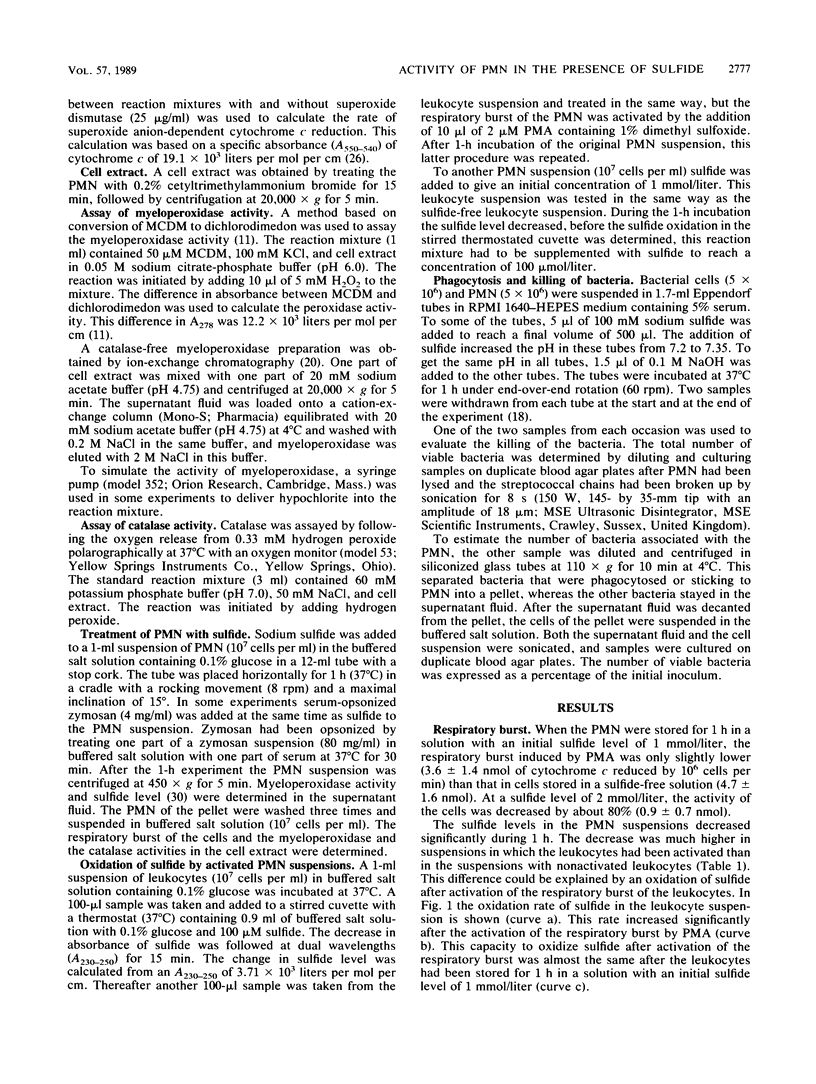
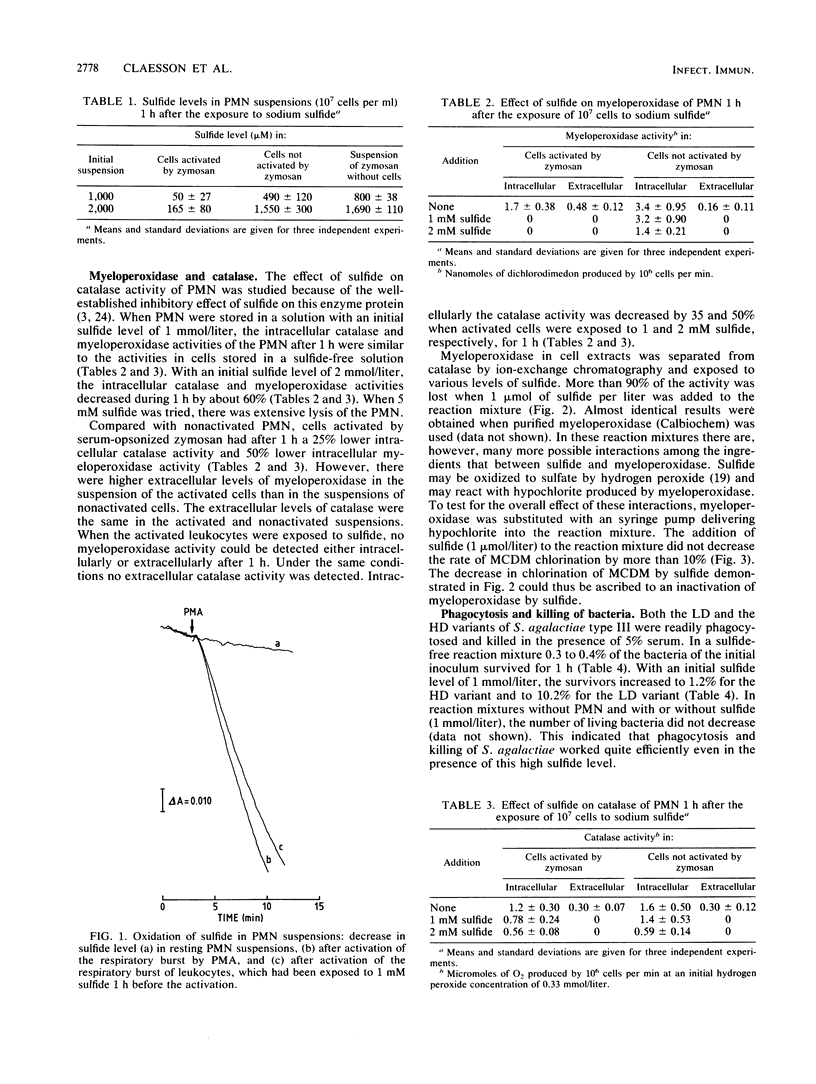
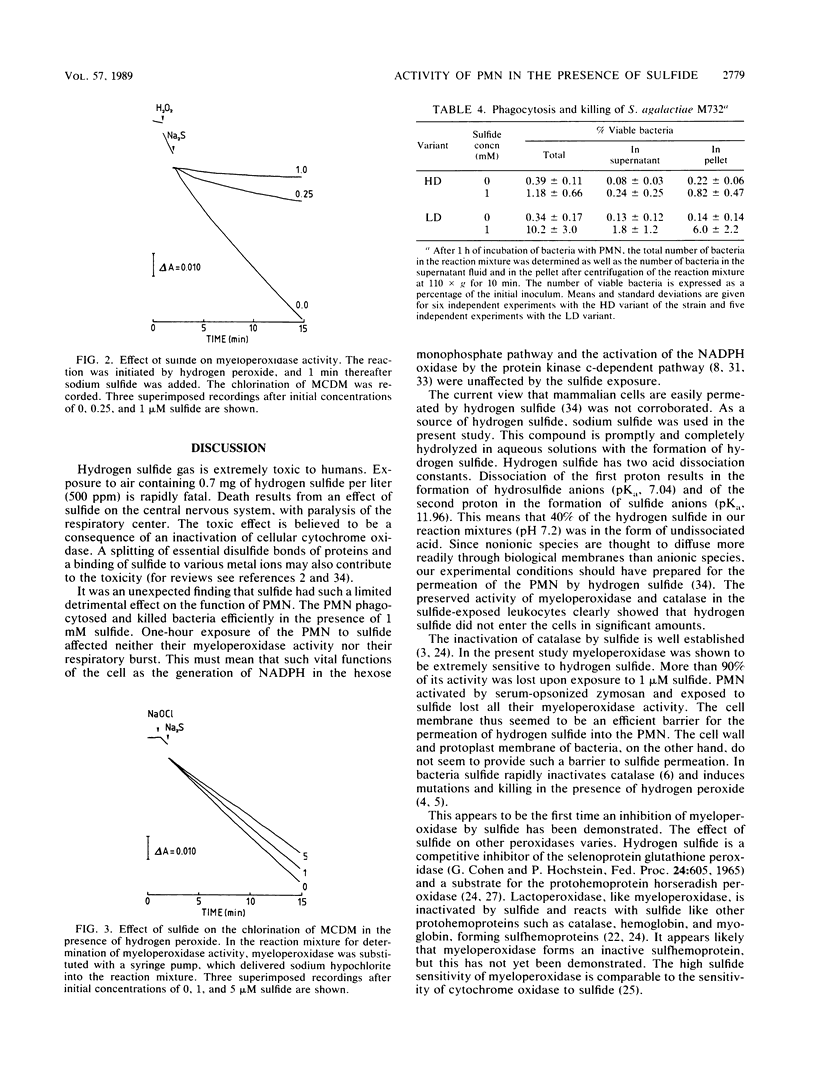

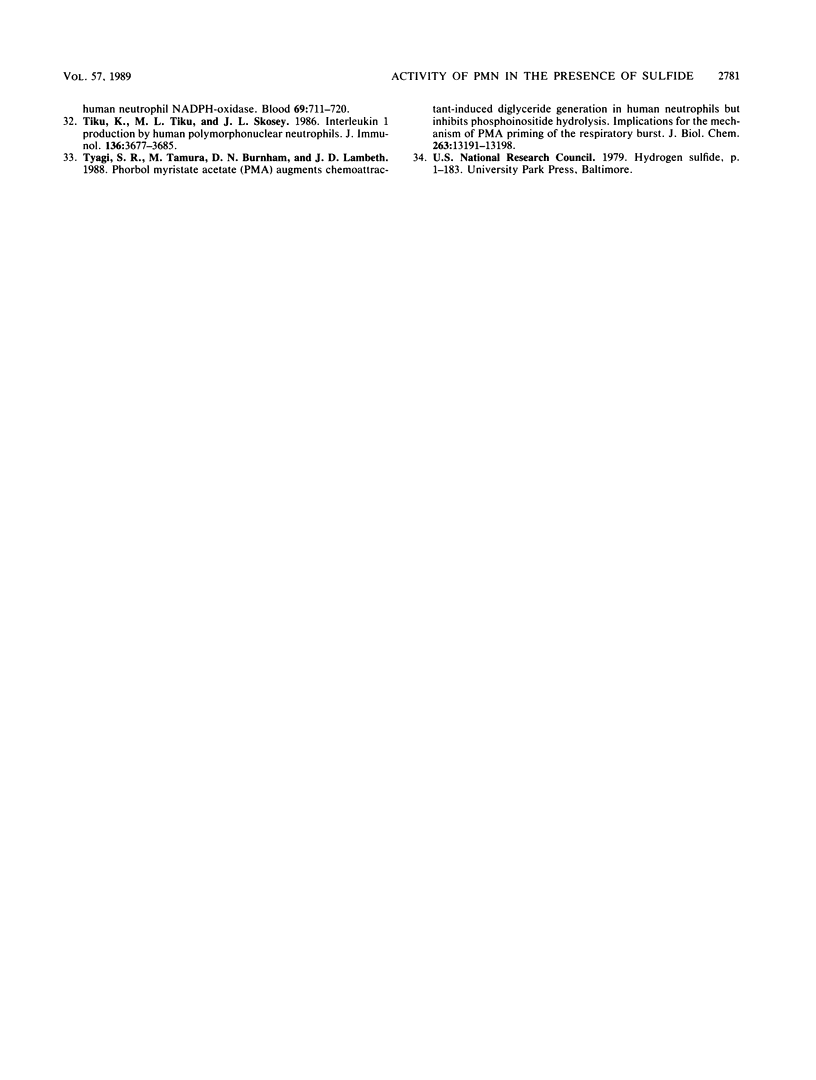
Selected References
These references are in PubMed. This may not be the complete list of references from this article.
- BEERS R. F., Jr, SIZER I. W. Sulfide inhibition of catalase. Science. 1954 Jul 2;120(3105):32–33. doi: 10.1126/science.120.3105.32. [DOI] [PubMed] [Google Scholar]
- Baker C. J., Edwards M. S., Webb B. J., Kasper D. L. Antibody-independent classical pathway-mediated opsonophagocytosis of type Ia, group B streptococcus. J Clin Invest. 1982 Feb;69(2):394–404. doi: 10.1172/JCI110463. [DOI] [PMC free article] [PubMed] [Google Scholar]
- Beauchamp R. O., Jr, Bus J. S., Popp J. A., Boreiko C. J., Andjelkovich D. A. A critical review of the literature on hydrogen sulfide toxicity. Crit Rev Toxicol. 1984;13(1):25–97. doi: 10.3109/10408448409029321. [DOI] [PubMed] [Google Scholar]
- Berglin E. H., Carlsson J. Effect of hydrogen sulfide on the mutagenicity of hydrogen peroxide in Salmonella typhimurium strain TA102. Mutat Res. 1986 Sep;175(1):5–9. doi: 10.1016/0165-7992(86)90137-5. [DOI] [PubMed] [Google Scholar]
- Berglin E. H., Carlsson J. Potentiation by sulfide of hydrogen peroxide-induced killing of Escherichia coli. Infect Immun. 1985 Sep;49(3):538–543. doi: 10.1128/iai.49.3.538-543.1985. [DOI] [PMC free article] [PubMed] [Google Scholar]
- Carlsson J., Berglin E. H., Claesson R., Edlund M. B., Persson S. Catalase inhibition by sulfide and hydrogen peroxide-induced mutagenicity in Salmonella typhimurium strain TA102. Mutat Res. 1988 Nov;202(1):59–64. doi: 10.1016/0027-5107(88)90163-7. [DOI] [PubMed] [Google Scholar]
- Cavallini D., Federici G., Barboni E. Interaction of proteins with sulfide. Eur J Biochem. 1970 May 1;14(1):169–174. doi: 10.1111/j.1432-1033.1970.tb00275.x. [DOI] [PubMed] [Google Scholar]
- Chakravarti B., Chakravarti D. N. Phagocytosis: an overview. Pathol Immunopathol Res. 1987;6(5-6):316–342. doi: 10.1159/000157062. [DOI] [PubMed] [Google Scholar]
- Clark R. A., Leidal K. G., Pearson D. W., Nauseef W. M. NADPH oxidase of human neutrophils. Subcellular localization and characterization of an arachidonate-activatable superoxide-generating system. J Biol Chem. 1987 Mar 25;262(9):4065–4074. [PubMed] [Google Scholar]
- Curtis C. G., Bartholomew T. C., Rose F. A., Dodgson K. S. Detoxication of sodium 35 S-sulphide in the rat. Biochem Pharmacol. 1972 Sep 1;21(17):2313–2321. doi: 10.1016/0006-2952(72)90382-6. [DOI] [PubMed] [Google Scholar]
- Hager L. P., Morris D. R., Brown F. S., Eberwein H. Chloroperoxidase. II. Utilization of halogen anions. J Biol Chem. 1966 Apr 25;241(8):1769–1777. [PubMed] [Google Scholar]
- Horowitz A., Folke L. E. Hydrogen sulfide production in the periodontal environment. J Periodontol. 1973 Jul;44(7):390–395. doi: 10.1902/jop.1973.44.7.390. [DOI] [PubMed] [Google Scholar]
- Håkansson S., Bergholm A. M., Holm S. E., Wagner B., Wagner M. Properties of high and low density subpopulations of group B streptococci: enhanced virulence of the low density variant. Microb Pathog. 1988 Nov;5(5):345–355. doi: 10.1016/0882-4010(88)90035-6. [DOI] [PubMed] [Google Scholar]
- Håkansson S., Holm S. E., Wagner M. Density profile of group B streptococci, type III, and its possible relation to enhanced virulence. J Clin Microbiol. 1987 Apr;25(4):714–718. doi: 10.1128/jcm.25.4.714-718.1987. [DOI] [PMC free article] [PubMed] [Google Scholar]
- Håkansson S., Holm S. Influence of polysaccaride capsule and ionic strength on buoyant density of group B streptococci. Acta Pathol Microbiol Immunol Scand B. 1986 Jun;94(3):139–143. doi: 10.1111/j.1699-0463.1986.tb03033.x. [DOI] [PubMed] [Google Scholar]
- Löfgren S., Tärnvik A., Bloom G. D., Sjöberg W. Phagocytosis and killing of Francisella tularensis by human polymorphonuclear leukocytes. Infect Immun. 1983 Feb;39(2):715–720. doi: 10.1128/iai.39.2.715-720.1983. [DOI] [PMC free article] [PubMed] [Google Scholar]
- Miyasaki K. T., Wilson M. E., Cohen E., Jones P. C., Genco R. J. Evidence for and partial characterization of three major and three minor chromatographic forms of human neutrophil myeloperoxidase. Arch Biochem Biophys. 1986 May 1;246(2):751–764. doi: 10.1016/0003-9861(86)90332-2. [DOI] [PubMed] [Google Scholar]
- Morhart R. E., Mata L. J., Sinskey A. J., Harris R. S. A microbiological and biochemical study of gingival crevice debris obtained from Guatemalan Mayan Indians. J Periodontol. 1970 Nov;41(11):644–649. doi: 10.1902/jop.1970.41.11.644. [DOI] [PubMed] [Google Scholar]
- NICHOLLS P. The formation and properties of sulphmyoglobin and sulphcatalase. Biochem J. 1961 Nov;81:374–383. doi: 10.1042/bj0810374. [DOI] [PMC free article] [PubMed] [Google Scholar]
- Nakamura S., Nakamura M., Yamazaki I., Morrison M. Reactions of ferryl lactoperoxidase (compound II) with sulfide and sulfhydryl compounds. J Biol Chem. 1984 Jun 10;259(11):7080–7085. [PubMed] [Google Scholar]
- Ng W., Tonzetich J. Effect of hydrogen sulfide and methyl mercaptan on the permeability of oral mucosa. J Dent Res. 1984 Jul;63(7):994–997. doi: 10.1177/00220345840630071701. [DOI] [PubMed] [Google Scholar]
- Nicholls P. The effect of sulphide on cytochrome aa3. Isosteric and allosteric shifts of the reduced alpha-peak. Biochim Biophys Acta. 1975 Jul 8;396(1):24–35. doi: 10.1016/0005-2728(75)90186-3. [DOI] [PubMed] [Google Scholar]
- Pick E. Microassays for superoxide and hydrogen peroxide production and nitroblue tetrazolium reduction using an enzyme immunoassay microplate reader. Methods Enzymol. 1986;132:407–421. doi: 10.1016/s0076-6879(86)32026-3. [DOI] [PubMed] [Google Scholar]
- Rizzo A. A. The possible role of hydrogen sulfide in human periodontal disease. I. Hydrogen sulfide production in periodontal pockets. Periodontics. 1967 Sep-Oct;5(5):233–236. [PubMed] [Google Scholar]
- Rogers R. E., Ferin J. Effect of hydrogen sulfide on bacterial inactivation in the rat lung. Arch Environ Health. 1981 Sep-Oct;36(5):261–264. doi: 10.1080/00039896.1981.10667634. [DOI] [PubMed] [Google Scholar]
- SIEGEL L. M. A DIRECT MICRODETERMINATION FOR SULFIDE. Anal Biochem. 1965 Apr;11:126–132. doi: 10.1016/0003-2697(65)90051-5. [DOI] [PubMed] [Google Scholar]
- Tauber A. I. Protein kinase C and the activation of the human neutrophil NADPH-oxidase. Blood. 1987 Mar;69(3):711–720. [PubMed] [Google Scholar]
- Tiku K., Tiku M. L., Skosey J. L. Interleukin 1 production by human polymorphonuclear neutrophils. J Immunol. 1986 May 15;136(10):3677–3685. [PubMed] [Google Scholar]
- Tyagi S. R., Tamura M., Burnham D. N., Lambeth J. D. Phorbol myristate acetate (PMA) augments chemoattractant-induced diglyceride generation in human neutrophils but inhibits phosphoinositide hydrolysis. Implications for the mechanism of PMA priming of the respiratory burst. J Biol Chem. 1988 Sep 15;263(26):13191–13198. [PubMed] [Google Scholar]


